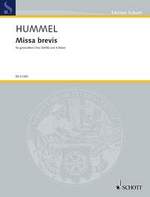Missa brevis for mixed choir and eight woodwind, op. 5a (1951)

I. Kyrie
II. Gloria
III. Credo
IV. Sanctus
V. Agnus Dei
Première:
October 12,1952, Donaueschingen, Katholische Stadtkirche
Freiburger Domchor
/ Bläser des Freiburger Philharmonischen Orchesters / Franz Stemmer
Winds: 2 Ob., (or Ob., Cor Angl.) , 2 Bssn., 2 Tpt. in C, 2 Trb.(evtl. Tuba)
Duration: 18 Minutes
Publisher: Schott MusicScore: ED 21285 / ISMN: 979-0-001-18036-8
Organ score ED 21285-1 / ISMN: 979-0-001-18037-5
Set of solo parts: ED 21285-11 / ISMN: 979-0-001-18038-2
The Missa brevis for mixed choir and eight woodwind, op. 5, was written in 1951. It was at the Donauesching Festival of Contemporary Music in 1952 that the work received its world première. The Ordinary of the Mass (Kyrie-Gloria-Credo-Sanctus-Agnus Dei) was composed using a modal technique drawing on elements of Gregorian chant and associated modes, taking medieval works as models. The Latin Mass text is set in a liturgically practicable way, compactly chiselled like a wood-carving. The austere diatonic sound of the "Missa brevis" results from the modal procedures in both vertical and horizontal planes. Ideally, the work should be performed during a liturgical celebration of the Mass.
Bertold Hummel
Press
Musica Sacra 2/1992
Missa Brevis" ,op. 5, for choir and eight woodwind, Hummel has written an original and many-sided work. Traditional elements such as the intonation of the Gloria and Credo appear alongside a moderately modern musical language and an unconventional dance-like Gloria.
CVO 2/1953
WORLD PREMIRÈRE
OF A "MISSA BREVIS" IN DONAUESCHINGEN
For the first time, the Donauesching
Festival of Contemporary Music has this year found a place for contemporary sacred
music and included it in the official programme. Considering the openness with
which efforts are made by church music to enter musically new land and its importance
for music generally, this inclusion is long overdue. Let us hope that musica sacra
nova has now gained a permanent place at the Donauesching music festival. It is
no longer the case that the relations between church music and modern music are
so completely broken down as in years past, and since church music is not tied
to historical styles, it can glorify the liturgy in the language of our times
as well. Every age has its own language, as the Popes in their utterances over
church music have repeatedly reminded us. Thus Pope Pius XII pleads in his encyclical
"Mediator Dei" (1947) for a healthy modernism and in so doing gives
new validity to the Psalm text "Sing to the Lord a new song ".
The new work we are discussing here is the "Missa brevis" for mixed
choir and eight woodwind, written in 1951 by Bertold Humrnel. The young Freiburg
composer (born in 1925), pupil of Genzmer, has demonstrated here, apart from his
great craftsmanship - including an unusual mastery of an idiosyncratic but never
affected compositional technique - an astonishing maturity and independence in
handling his material and has created a valid work in which contemporary musical
syntax finds liturgical expression. The musical language, taking its melodic and
thematic influence from Gregorian chant, is free of all dependence on traditional
harmonic patterns and functionality; on the contrary, the formation of chords
- as far as we can talk of chords in the normal sense here - results from independent
factors, the horizontal and vertical lines pursue their own goals and are governed
by the logic of voice leading rather than considerations of simultaneous sound
perception. This ascetic strictness applies to the treatment of the text as well,
which, in its elevated declamation in Gregorian style, leaves no room for attempts
to expound details. In their claims to dominant positions in the total musical
structure, the contestants homophony and polyphony insist separately on their
rights. The tasks of the woodwind (2 oboes, 2 bassoons, 2 trumpets, 2 trombones)
have in the same way no intention of melting into a unified sound with the voices,
as we are accustomed from Masses with instruments, but rather in their mixture-like
sounds and episodes occasionally even appear to be without relationship to the
whole complex, so that one might find the justification of their use not always
completely clear. But this Mass, seen as a whole, is undoubtedly a conception
which goes its own way in the liturgical field, a work in which the great talent
and, implicitly, as it seems to us, the great potential of this young composer
are clearly to be felt. We have proof of this already in his chamber music. Cathedral
Choirmaster Professor Franz Stemmer is well known on the one hand for his keen
sifting but on the other hand for his consistent commitment to recognising and
helping up from its baptism valuable new musica sacra. With this new work, he
has identified with the aims of the composer convincingly and out of genuine conviction.
With his Cathedral Choir and woodwind of the Freiburg Philharmonic Orchestra,
he has conducted a première in the Catholic City Church, Donaueschingen,
which, above all in terms of total concept, offered an uncommonly integrated and
powerful interpretation. Immediately after the Donauesching première, Cathedral
Choirmaster Professor Franz Stemmer arranged for the work to be performed in Freiburg
Minster, where it met with very positive resonance.
Dr. M. Ganter

